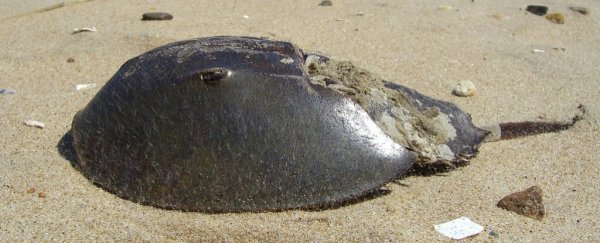Researchers in Japan have reported finding up to 500 dead horseshoe crabs on the tidal flat in Kitakyushu - one of the creatures' largest breeding grounds.
This is a major concern, because even though horseshoe crabs do die there every year when thousands of them huddle together to breed, this year's death rate is 10 times higher than usual, and no one knows why.
"Rises in the sea level caused by global warming, shortages of places to lay eggs and a lack of nutrition could have resulted in their deaths," researcher Hiroko Koike from Kyushu University Museum told Takuya Miyano from The Asahi Shimbun. "We have to be careful to identify the cause."
Horseshoe crabs are arthropods, and despite their name, they're more closely related to spiders and scorpions than they are to crustaceans like real crabs. They can also grow pretty large, with adults weighing up to 6 pounds (2.7 kilograms) and measuring 24 inches (60 centimetres) long.
What's perhaps most noticeable about horseshoe crabs is that they've barely evolved over their 450-million-year existence.
But now after surviving the last five mass extinctions on Earth, their numbers are suddenly starting to dwindle.
According to Akshat Rathi at Quartz, the tidal flat in Kitakyushu isn't the only place where horseshoe crabs have started to die off. One of the hardest hit areas is the coast of India, where two of the four known species of horseshoe crab thrive.
Based on a recent report presented by the International Union for Conservation of Nature (IUCN), these two species are now on the brink of extinction, mainly due to habitat loss.
While the exact reasons for why all four horseshoe crab species are now suddenly on the decline is still a mystery, researchers think it's largely to do with two main factors: global warming - which is causing sea temperatures to rise and destroy habitats - and overfishing.
A recent meta-analysis by an international team of researchers found that the world's oceans have largely been shielding us land-dwellers from the adverse effects of global warming for many years now, leading sea temperatures to rise steadily, threatening many of the world's ocean-based ecosystems.
As we reported earlier this month:
"Because oceans take up so much surface area on our planet, as radiation from the Sun hits them, the heat is quickly dissipated. In a world without the oceans, much of that heat would have remained, after bouncing off landmasses and getting trapped in the atmosphere - causing the planet to warm much faster than ours is right now."
These findings make it easy to see how horseshoe crabs - along with many other sea creatures - are finally starting to show the effects that rising sea temperatures can have.
The other problem - overfishing - is a bit stranger. There is little demand for horseshoe crabs as food, but the species has gained a lot of attention from a therapeutic standpoint, with their eerie blue blood becoming something of a medical curiosity in recent years.
Horseshoe crabs have a specific chemical in their blood known as limulus amebocyte lysate (LAL), which surrounds bacteria as soon as it detects it, and prevents it from spreading.
In order to make sure intravenous medications are completely safe for humans, labs have started using the compound harvested from horseshoe crabs because, right now, it's the most efficient way to do so.
"[L]imulus amebocyte lysate (LAL) … thickens when it comes in contact with toxins produced by bacteria that can cause life-threatening conditions in humans," Rathi reports for Quartz. "Labs use LAL to test its equipment, implants, and other devices for these toxins."
Those harvesting this 'blue blood' say they're not killing the crabs to obtain it, but reports have shown that even if crabs that are returned to the ocean afterwards, they tend to die earlier than those that had been left alone.
Scientists are now trying to develop a synthetic version of LAL, and if they can find an adequate replacement, it will greatly reduce our dependence on horseshoe crabs.
More research is needed to fully understand the cause of the current horseshoe crab population decline, but it will hopefully offer up ways that conservationists can start helping them rebound.
